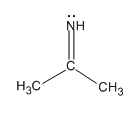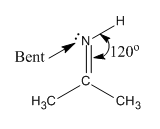
Concept explainers
Interpretation:
Molecular geometry and electron geometry about nitrogen atom in the acetone imine molecule is to be predicted.
Concept introduction:
Electron geometry and molecular geometry of molecules is determined by using Valence shell electron pair repulsion (VSEPR) theory. According to VSEPR theory, electron geometry describes the orientation of the electron groups about a particular atom, and molecular geometry describes the arrangement of atoms about a particular atom.
Number of electron pairs describes the electron and molecular geometry. If all the electron pairs are bonds, then molecular geometry is the same as electron geometry. Electron geometry is different from molecular geometry if some electron pairs are present as lone pairs.
Electron geometry and molecular geometry from the number of electron pairs are as follows:
| Number of electron pairs |
Number of Bonds |
Number of Lone pair |
Electron geometry | Molecular Geometry |
| 2 | 2 | 0 | Linear | Linear |
| 3 | 3 | 0 | Trigonal planar | Trigonal planer |
| 3 | 2 | 1 | Trigonal planar | Bent |
Answer to Problem 2.1P
Electron geometry about N atom in acetone imine molecule geometry is trigonal planar and molecular geometry is bent.
Explanation of Solution
The given acetone imine molecule is

In acetone imine molecule, there are total three groups of electrons about N atom. There is one double bond, one single bond, and one lone pair around N atom, that is, all electron pairs are not involved in bond formation, and hence, molecular geometry and electron geometry are different.
There are total three electron groups, hence, the electron geometry about N atom is trigonal planar. The molecular geometry is bent.

Electron geometry and molecular geometry about N atom is predicted from the number of electron pairs present around the atom in the given molecule.
Want to see more full solutions like this?
Chapter 2 Solutions
Organic Chemistry: Principles and Mechanisms (Second Edition)
- Calculate the pH and the pOH of each of the following solutions at 25 °C for which the substances ionize completely: (a) 0.000259 M HClO4arrow_forwardWhat is the pH of a 1.0 L buffer made with 0.300 mol of HF (Ka = 6.8 × 10⁻⁴) and 0.200 mol of NaF to which 0.160 mol of NaOH were added?arrow_forwardDetermine if the following salt is neutral, acidic or basic. If acidic or basic, write the appropriate equilibrium equation for the acid or base that exists when the salt is dissolved in aqueous solution. If neutral, simply write only NR. Be sure to include the proper phases for all species within the reaction. NaN₃arrow_forward
- A. Draw the structure of each of the following alcohols. Then draw and name the product you would expect to produce by the oxidation of each. a. 4-Methyl-2-heptanol b. 3,4-Dimethyl-1-pentanol c. 4-Ethyl-2-heptanol d. 5,7-Dichloro-3-heptanolarrow_forwardWhat is the pH of a 1.0 L buffer made with 0.300 mol of HF (Ka = 6.8 × 10⁻⁴) and 0.200 mol of NaF to which 0.160 mol of NaOH were added?arrow_forwardCan I please get help with this.arrow_forward
- Determine if the following salt is neutral, acidic or basic. If acidic or basic, write the appropriate equilibrium equation for the acid or base that exists when the salt is dissolved in aqueous solution. If neutral, simply write only NR. Be sure to include the proper phases for all species within the reaction. N₂H₅ClO₄arrow_forwardPlease help me with identifying these.arrow_forwardCan I please get help with this?arrow_forward

 Organic Chemistry: A Guided InquiryChemistryISBN:9780618974122Author:Andrei StraumanisPublisher:Cengage Learning
Organic Chemistry: A Guided InquiryChemistryISBN:9780618974122Author:Andrei StraumanisPublisher:Cengage Learning Chemistry for Today: General, Organic, and Bioche...ChemistryISBN:9781305960060Author:Spencer L. Seager, Michael R. Slabaugh, Maren S. HansenPublisher:Cengage Learning
Chemistry for Today: General, Organic, and Bioche...ChemistryISBN:9781305960060Author:Spencer L. Seager, Michael R. Slabaugh, Maren S. HansenPublisher:Cengage Learning Chemistry: The Molecular ScienceChemistryISBN:9781285199047Author:John W. Moore, Conrad L. StanitskiPublisher:Cengage Learning
Chemistry: The Molecular ScienceChemistryISBN:9781285199047Author:John W. Moore, Conrad L. StanitskiPublisher:Cengage Learning





